How To Refine And Perfect Your Home Defense Strategy
One of the duties of a free citizen is to take the grave responsibility of securing his well-being and property. An assurance and feeling of safety is a good thing indeed. Despite the narrative of chaos and doom, for the most part (outside of certain cities) our nation is a place of safety and calm. Peaceable citizens go about their days and nights, respecting the personal and property rights of others. However, on occasion, that calm does get shattered, and it can even happen at home. In a legal and very real sense, one’s home is a castle. In bygone times, kings, lords, dukes, viscounts, marquesses, and earls all took great steps to secure their keep.
As the earl and master of one’s domain, a home defense strategy is essential. It may never come into play, but if it does, those preparations will pay off in spades.
So, how does one refine and perfect a home defense strategy?
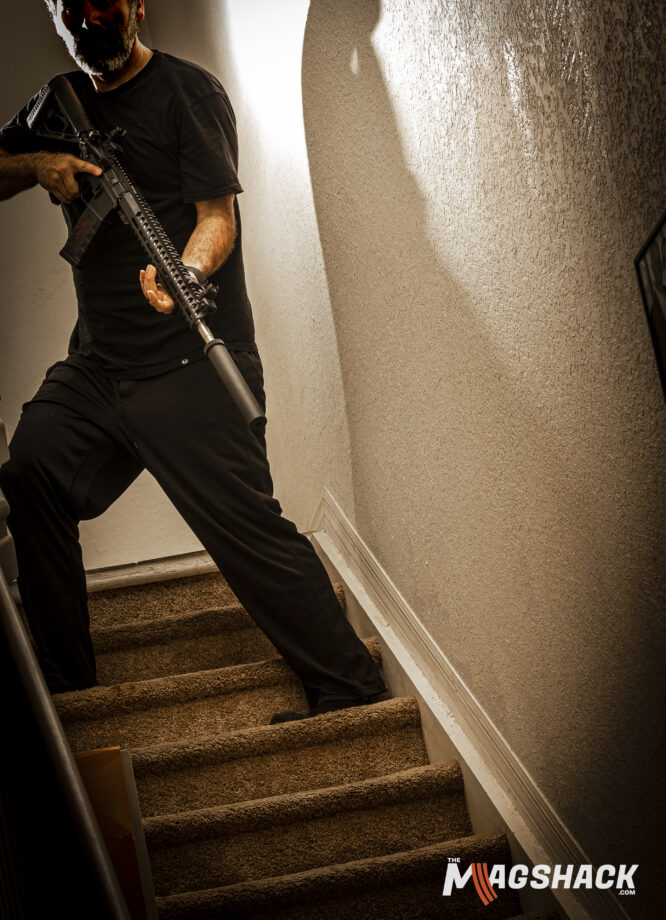
The Boring Stuff, i.e. Not Getting Into A Fight
As ardent supporters of the Second Amendment and the right to keep and bear arms, those of us at The Mag Shack and people in our orbit tend to be very firearms-centric. Which is understandable. It’s what we do all day.
However, as some notable firearms instructors have said – the easiest way to win a gunfight is to not get into one.
As has been discussed on this blog before, “A little bit of yourself leaves the barrel of your gun if you have to shoot someone that day…”. Even on one’s home turf, shooting someone in self-defense is a chaotic and intense business. From a tactical perspective in most scenarios, opening fire on someone should be a last resort and not the default response.
Think of home defense as a system of layers. Under normal circumstances, it’s not advisable to shoot someone who hasn’t achieved entry into your home, even if they are attempting to do so. Criminals are mostly opportunists and seek the easiest and fastest route. Simple and common-sense tactics should form the first layer of defense.
Lock The Doors!
Your average thief is looking for a quick score. Armed or not, under the influence or not, they want to be in and out. If they’re cruising a neighborhood, they’ll skip a place that takes some effort to get into. Stout doors with well-made locks are a deterrance. Check those windows and vents as well.
Light Up The Night
If possible, leave external lights on, or invest in motion-sensing lights. The latter can easily startle an unwary thief into going somewhere else.
An Alarm System
Whether it’s a noisemaker with window sensors and glass-break detectors or a full-on system that notifies a central monitoring station, an alarm system is invaluable. At a basic level, it serves as an early warning system for intrusions.
Surveillance, The Eye In The Sky
While professional-level NVR surveillance systems can run into the tens of thousands of dollars, most citizens don’t require that level of sophistication. Through popular websites such as the one named after the river in Brazil and specialty shops, one can acquire a “does the job well” NVR surveillance system for a few hundred dollars. With enough resolution to see what’s going on and active IR night vision, having a bit of recon is invaluable. Thieves know this, and may be deterred by the sight of cameras. Conversely, if they see cameras they may think there are things of value on the premises. Consider camera placement accordingly.
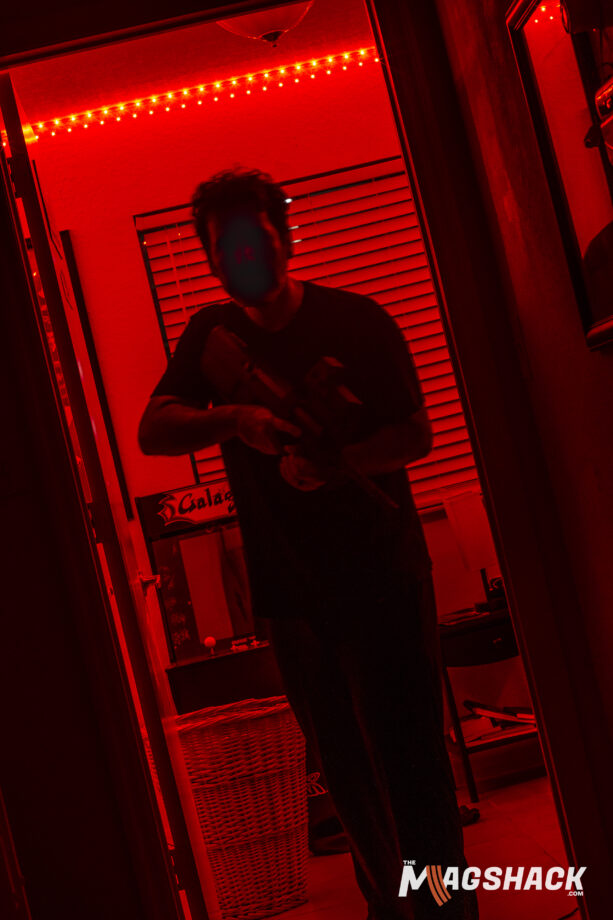
Armed response is the last resort of a home defense strategy.
The Last Resort, An Armed Response.
The door’s been breached, the alarm is wailing, lights are coming on. The dog is barking. The cat is nowhere to be found. Be that as it may, some bad dudes have entrered and are going for the smash-and-grab. Legally, they are fair game for an armed response. So, what’s the plan? Mag dumps in their general direction? Two pumps of a shotgun? It’s not that simple, unfortunately. Your firearm is coming out, and the stakes have changed, significantly. In the country of the mind, one might imagine every resident of the home in Condition Red. Dad has a suppressed M4 and a full combat load of magazines from The Mag Shack, Mom has an MP5SD and just gave it a slap. Junior has a 3D-printed Welrod pistol, and even Baby has a Lifecard .22 LR.
Unfortunately, the real world doesn’t work that way, and in reality, it shouldn’t. Multiple parties engaging multiple targets in a confined space is the provenance of those who press a trigger for a living and train extensively for it. One needs a strategy.
Get Vulnerable Residents To Safety
A good home defense strategy involves everyone on-premises. Rehearse and plan accordingly. If the very young or very old are on hand, task someone capable to immediately see to their safety. That person should be armed, if possible. Their goal is to secure them all in one area, and not move until an all-clear signal is given. Discuss a “codeword”, i.e. something the primary defending person can shout out when the situation is under control.
Have Law Enforcement En Route
In the case of a home defense scenario, everyone has a job to do, even if they are individually armed. One person should be assigned the role of communications. While someone is handling the present danger, another should be dialing 911 and getting law enforcement en route. While the police will arrive too late to add to the defensive strategy, it is important to summon them, especially for legal reasons. Even in places where castle doctrine is a solid legal foundation, it has been known for the families of criminals to attempt legal action of their own. You want the police on hand to document the situation, along with EMTs to handle any injuries – yes, even of the home invaders.
Rehearse Your Strategy
To quote Clausewitz, no plan survives first contact with the enemy. However, it is eminently better to have a plan than no plan at all. And more importantly, it must be rehearsed. With firearms cleared and rendered safe, have all residents rehearse their roles and movements for a home defense scenario. While reality dictates that the plan may fall apart, the hope is that some elements may remain intact, enough to successfully defend one’s home. Also, train how you fight. If you think you’ll be fighting in your bedclothes, wear your bedclothes during “rehearsals”.
Technical Considerations of An Armed Response To A Home Invasion
Part of one’s plan for a home defense scenario includes (yes the fun part!) the selection of the proper firearms for a defensive situation. While it may be almost instinctual to just grab an AR-pattern rifle or that somewhat-neglected AK when things go bump in the night, it may not be the wisest decision, and selecting the wrong firearm and ammunition can actually be quite dangerous to unintended targets, i.e. neighbors, people in other rooms of the house, and so forth. The selection of the proper firearm and ammunition combination is of paramount importance.
Consider The Property
Not all homes are the same of course. Whether it’s a standalone house, a townhome, a condo, or an apartment, each type of dwelling presents its own challenges to successful home defense. And within each dwelling type, there are an almost infinite number of variables. Are the hallways wide or narrow? What are the walls made of? Are their neighbors close by or adjoining the home in their own dwelling? How many floors? All this must be evaluated, and the conclusions from that evaluation determine the best firearm and ammunition combination.
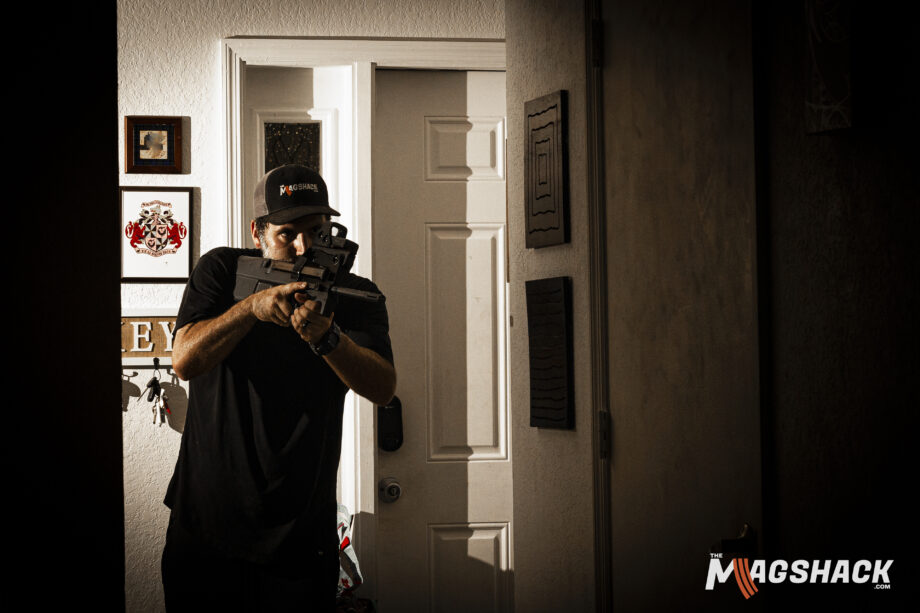
The Suitability Of A Rifle
Utilizing a rifle such as an AR15 or AK47 in a home defense situation has its advantages and disadvantages. Despite lore and legend, a modern well-designed rifle such as the AR is ergonomic, easy to learn, and at least with 5.56mm ammunition, has a very forgiving and mild recoil. One can learn the basics of an AR in about an hour, even if one is a complete newbie to firearms. An AK-pattern rifle is a little less forgiving in all those aspects, but not by a huge degree.
With these characteristics, a modern rifle such as an AR15 or AK47 can be deployed in a home defense situation effectively, even under duress. With the larger frame of the weapon soaking up most of the recoil of the mild 5.56mm and 7.62x39mm rounds, it’s a marked advantage to the defending party, especially in terms of shot placement.
However, the size of a rifle does make maneuvering in close quarters difficult, especially in the narrow hallways present in apartments, townhomes, and condos. The higher velocity of a rifle projectile also presents an increased risk of overpenetration, where a miss can send a round through a wall into the next room, or the next unit, potentially striking an unintended target. With a rifle, ammunition selection is critical. More on that later.
The size of a rifle can be mitigated somewhat if one chooses to purchase either a short-barreled rifle (under 16 inches in barrel length) or a large-format pistol that uses rounds usually associated with a rifle. Sidebar: The pistol brace question hasn’t been settled as of this writing, so tread carefully.
The Suitability Of A Pistol
In the United States, the most common firearm of any of the major types is, of course, the handgun or pistol. Whether it’s a GLOCK 19 or a classic J-frame wheelgun, Americans have purchased more pistols throughout history than any other type of weapon. Invariably, this means most will choose to defend their home with a pistol.
The small size and portability of a pistol are ideal for the close quarters present in a smaller dwelling, such as a condo or apartment. One can maneuver with ease through the corridors and stairwells, and not risk bumping their firearm into a wall or door. In addition, the lower velocity of pistol ammunition lessens the risk of overpenetration, but only with proper hollow point defensive rounds.
However, a pistol is a more difficult firearm to deploy with accurate results. The smaller size of a pistol will soak up less recoil, which requires more training for the end user. While more training for any firearm platform is essential, home invaders usually don’t wait for one to master a weapon before invading.
The Suitability Of A Shotgun
In classic films and literature, it’s often depicted that the resident of a home will grab a venerable old scattergun in a home defense situation. With two blasts from the weapon, the invader collapses or flees the scene from the concussive blast. Unfortunately, again, the reality is a little different.
Like a rifle, a shotgun is a larger-format weapon and presents an easy manual of arms to operate. In addition, a shotgun is usually the easiest firearm to acquire in restrictive jurisdictions. Shotgun ammunition, especially in the ubiquitous 12 gauge, is plentiful and cheap as well.
However, there are marked disadvantages to using a shotgun for home defense. Whether it’s buckshot, birdshot, or a slug, overpenetration is surprisingly a concern. Numerous ballistic reports show that common 12 gauge loads over-penetrate through drywall and wood, increasing the risk of hitting an unintended target. In addition, the stout recoil of most shotguns can be intimidating to a less-trained user. The larger size of a shotgun also presents maneuverability issues, as well.
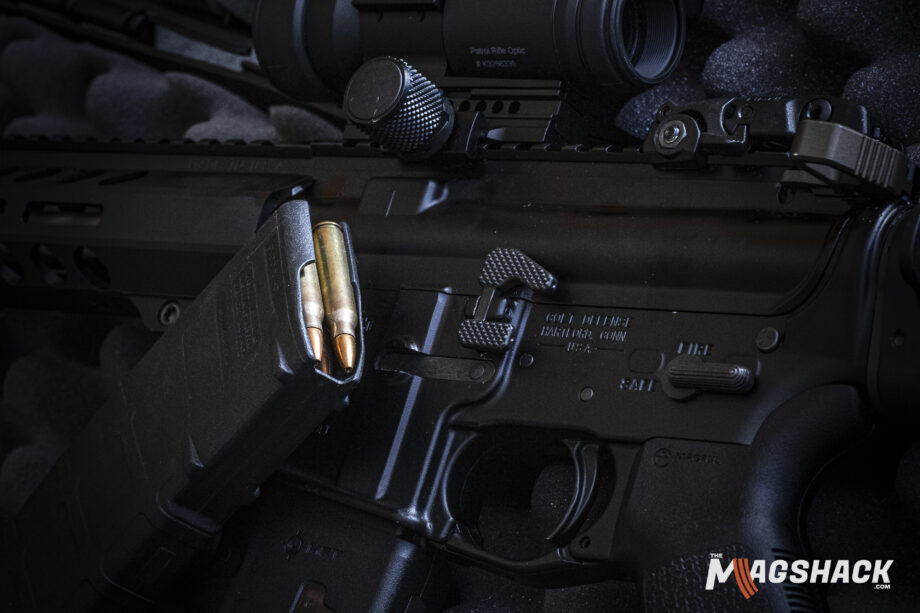
Ammunition selection for home defense is of paramount importance
Ammunition Selection
Regardless of what firearm one selects for the purposes of home defense, ammunition selection is of paramount importance as well. The key factor is the balance between the ability of a given round to neutralize a threat, and also the ability of a given round to not over-penetrate, i.e. pass through a target and strike something unintended.
The easiest way to narrow down the selection is to rule out all “ball” and full-metal jacket loads. Designed mostly for training and combat use where overpenetration isn’t a concern, full-metal jacket rounds, whether it be from a rifle or pistol, will generally keep on going through a target, and can easily penetrate materials like drywall and wood.
For handguns, your ideal choice for home defense ammunition should be a hollow-point load from a major manufacturer such as Federal, Speer, or Hornady. Avoid any “exotic” projectiles, no matter how effective the manufacturer says they are. Ideally, your ammunition should have a proven track record in both law enforcement and citizen use.
For rifles, it gets a little more complicated but not unbearably so. Most of the time, one will be feeding their AR with 5.56mm full-metal jacket ammo such as M193 or M855. While both loads are great for training, they are poor for defensive use in a non-combat situation. As with any FMJ projectile, both M855 and M193 will easily pass through a target, and keep going. In an indoor situation, this is hazardous, to say the least.
Similarly, for rifles chambered in 7.62x39mm, i.e. AKs, or .308, i.e. AR-10s, full-metal jacket loads should be avoided.
Instead, seek out loads that sport either a jacketed soft-point projectile or a hollow-point projectile. Major manufacturers like Speer, Federal, and Hornady offer an entire range of dedicated defensive ammunition for common rifle calibers, yes even in 7.62x39mm!
While dedicated defensive ammunition for your AR or AK-pattern rifle can be a little more expensive, the peace of mind is worth it. A fringe benefit is that the costlier rounds tend to be more accurate out of a given weapon.
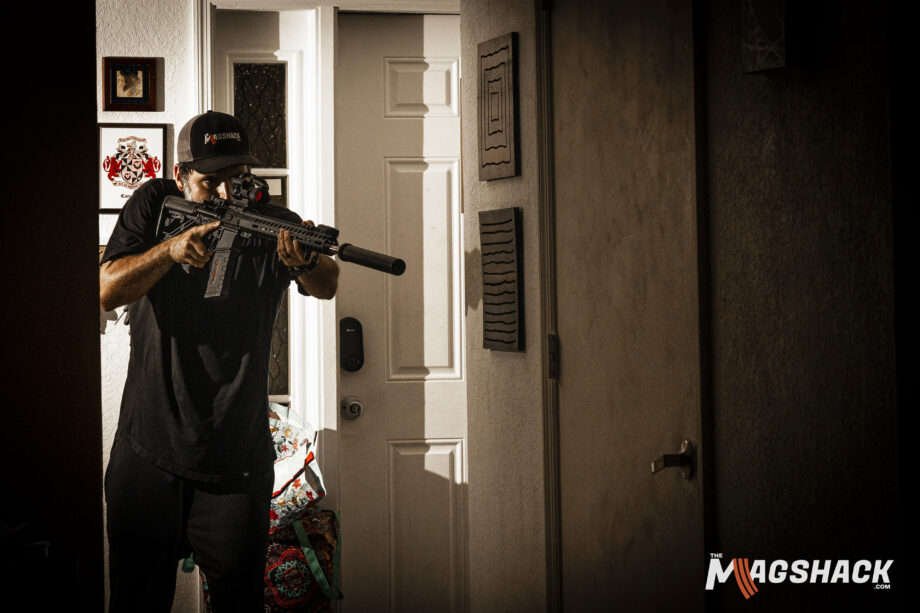
A suppressor is eminently useful in a home defense scenario
Other Considerations
For one’s defensive setup, there are other accessories that could be classified as falling into the “nice to have” category but aren’t necessarily a hard and fast requirement.
For example, fitting a suppressor to a dedicated home defense rifle or handgun would give a defending party a marked advantage in an invasion scenario. Gunshots are loud, and even more so in the confined spaces of a home. A suppressor can mitigate hearing loss and disorientation on the part of the defending party, enabling more effective follow-up actions, if needed. However, under current US law, suppressors are difficult to acquire legally, with the attendant months of waiting and a $200 National Firearms Act tax on top of everything else. Additionally, in some states (the obvious ones!) suppressors are flat-out illegal for private citizen possession and use.
An alternative would be to keep a solid set of electronic noise-canceling earmuffs on standby with your defensive setup. Staging them properly would enable one to don them in a rapid fashion, being prepared for the situation at hand. The disadvantage of course would be ensuring they have a full battery charge at all times.
Another consideration is having as much ammo “on tap” as possible. A drum magazine from The Mag Shack could prove useful.
Also, whether it’s for a rifle, shotgun, or pistol, a weapon-mounted light is essential. Target identification is of paramount importance. That invader could be a family member coming home late, for example.
In addition, it would be wise to invest in both a proper first-aid kit and consider taking a “stop the bleed” course or something similar. Unfortunately in a home invasion scenario, people aside from the invading party can be injured, and seriously. As the fight ends, another fight of a different nature can very well begin. It pays to be a very well-rounded defender, a Renaissance Man (or woman) of sorts.
Home Defense – A Serious Business
While discussing the ins and outs of refining and perfecting a home defense plan is engaging and fun, the core issue itself is serious business. A home defender is taking personal responsibility for his or her life, and the lives of those under their care. A multi-layered and multi-faceted plan is essential. From the “first layer” of surveillance, alarms, and general best practices, to the ultimate layer of effecting an armed response, all factors must be considered. An effective plan and strategy tilt the odds ever in the favor of the defender.
Pick up magazines and other essential home defense accessories at The Mag Shack!